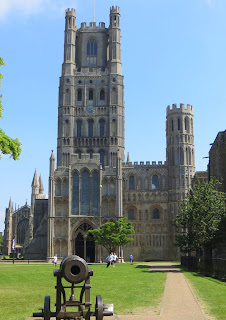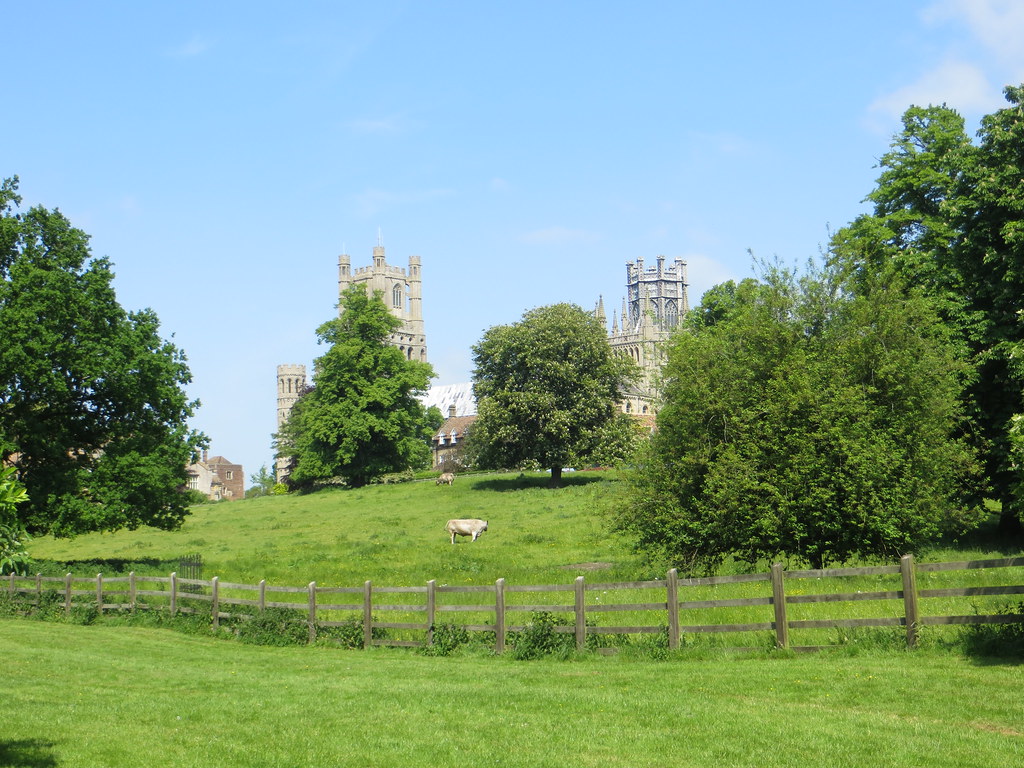Monday, 22 February 2021
Thursday, 18 February 2021
A tale of two cities: WInchester (3)
Wednesday, 17 February 2021
A tale of two cities: Winchester (2)
| On doing the outside (as you must to get to the café), the path passes this statue to the extraordinary William Walker, who toiled for years among the Cathedral's foundations to shore them up against encroaching ground water.
Small wonder that in the surrounding streets there's a pub named after him, complete with diver's helmet as its sign. |
Tuesday, 16 February 2021
A tale of two cities: Winchester (1)
Monday, 15 February 2021
A tale of two cities: Ely (3)
It might have something to do with the fact that it's pointing straight at the house that Oliver Cromwell lived in during the 1630s and 1640s, as a rising farmer, country gentleman, Presbyterian (and no fan of bishops, cathedrals or stained glass), and MP.
Part of the ground floor doubles as the Tourist Information Office, but the rest is devoted to presenting the domestic interiors of the day.
Upstairs, there's an outline history of the causes and conduct of the Civil Wars, exploring Cromwell's record as he emerged as a leader in Parliament, army general and ultimately, as "Lord Protector", more or less military dictator and monarch in all but name. Visitors are invited to rate him Hero or Villain - it seemed it had been running around 65-35 in favour of "Hero", reinforcing (for those who remember their 1066 And All That) the view that the Roundheads were Right but Repulsive and the Cavaliers Wrong but Wromantic.
A few streets away there's a small local history museum, with plenty for school parties to get to grips with, from prehistoric finds to the draining of the Fens around about (Cromwell's first big local issue as an MP, standing up for displaced local farmers), eel-fishing (hence the town's name), the history of the assorted criminals and unfortunates who ended up in the building when it was the Bishop's Gaol, and Ely's experience in WW2 as a centre for both evacuees from London and massive numbers of airmen on bases nearby.
Those apart, it's a pleasant, busy and reasonably well-serviced small town, though my photos don't capture much of that (I can never get over the habit of not taking pictures of the humdrum and everyday, even though that might be of most interest to others). The bland chainstore frontages of the main shopping streets somewhat conceal interesting side alleyways.
And on the way back to the station, it's worth a diversion to a well-pubbed waterside:
Sunday, 14 February 2021
A tale of two cities: Ely (2)
 |  |
and the view of the interior, and particularly its roof, is equally impressive:
So are its stone, metal and wooden fixtures and fittings:
Some of the decoration, particularly the painted ceiling, is Victorian, part of the revival of interest in mediaeval styles previously dismissed as too papistical. The really distinctive thing about the Cathedral is, however, original: well, almost. The Octagon Tower was built in 1322 to replace an earlier Norman tower that had collapsed.
Victorian, too, are the stained glass windows; but upstairs in a side gallery, heralded by the play of coloured light from the windows on the floor, is the Stained Glass Museum, all about how it developed, and is made to this day, with plenty of examples, not only mediaeval but also early twentieth-century domestic and contemporary aesthetic (with plenty of Victorian stuff in between):
Saturday, 13 February 2021
A Tale of Two Cities: Ely (1)
 It was originally the heart of a massive mediaeval monastery, whose purlieu took up most of where the modern town stands. On the Dissolution of the Monasteries, Henry VIII allowed the Cathedral to stand, and many of the surrounding buildings to become the King's School, which is there to this day, and mostly behind walls, off-limits to the passer-by.
It was originally the heart of a massive mediaeval monastery, whose purlieu took up most of where the modern town stands. On the Dissolution of the Monasteries, Henry VIII allowed the Cathedral to stand, and many of the surrounding buildings to become the King's School, which is there to this day, and mostly behind walls, off-limits to the passer-by. But lest you think this place is entirely other-worldly, the old gate house to the Cathedral/School area contains a library which is keeping up with the times.
Thursday, 11 February 2021
I'm covered. Sort of.
Tuesday, 9 February 2021
Last weekend, tempted by a newspaper piece on making orange curd and spotting some Seville oranges in the supermarket, I had a bash at making both the curd and some marmalade (well it helps to pass the time).
The curd turned out fine, but the latter was a bit runny, so to get on with using it up, this weekend meant making a marmalade cake, with some of the curd as the middle layer.
It wouldn't win prizes (not exactly the lightest and fluffiest of sponges, and signs of the dreaded soggy bottom) - but it tastes good. And that'll do me.











































